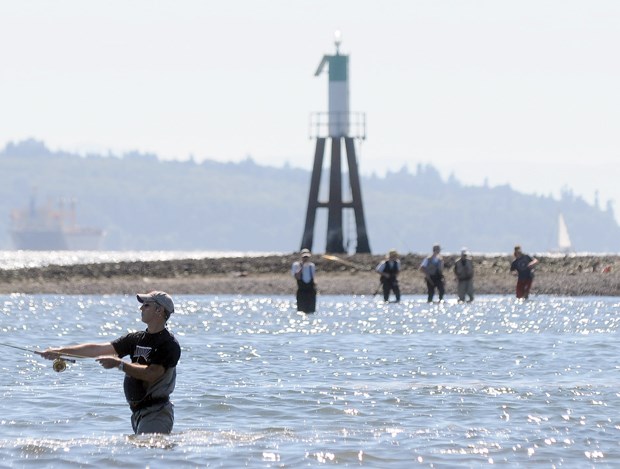Just as drivers are expected to know the rules of the road before getting behind the wheel, recreational fishermen are expected to know the rules of the water before casting a line.
Summer is a busy season for sport fishing and the Department of Fisheries and Oceans is reminding residents to do their research, or risk the penalties.
The first thing to consider is licensing. Federal fishery officer Catriona Day explains that different licences are required for the different fishing hot spots on the North Shore.
While Capilano River (above the BCR bridge) and Rice Lake require a provincially issued freshwater (non-tidal) fishing licence, the waters off Ambleside require a federally-issued tidal waters fishing licence.
Additionally, those wanting to keep any species of salmon must obtain a special stamp.
"Know your daily limits," Day says, explaining that fish maximums change depending on the season and species. "Sometimes it's one, sometimes it's two, sometimes it's four and, depending on the species, sometimes it could be by kilogram."
It's also important that fishermen know how to identify different species so they don't keep a fish they shouldn't.
"Sometimes chinook will be open and sockeye will be closed, or pink will be open and coho will be closed, so people need to know what each salmon looks like," Day says.
In the Lower Mainland, retaining rockfish is prohibited and Rockfish Conservation Areas up Indian Arm and around parts of West Vancouver are off limits to angling entirely.
Fishing in a closed area is subject to a $250 fine.
Crabbing off Ambleside Pier is a popular summer activity that's permitted with a tidal waters licence but only male crabs, identifiable by the shape of their abdomens, can be kept. The catch limit in the region is four per day.
Crabbers are also advised to buy calipers to measure their catches.
Dungeness crabs must be at least 165 millimetres wide to retain.
"Even a millimetre under is illegal and needs to be thrown back and it's ticketable $150 for one crab undersize and $50 for every crab undersize after that," Day says. "It's a pretty severe offence."
Due to contamination concerns, harvesting of bivalve shellfish in the region is prohibited.
"There's nowhere in the Lower Mainland that's open to digging for clams or mussels or scallops or cockles or anything with two shells."
There are lots of rules and regulations when it comes to recreational fishing, which change frequently depending on conditions, but Day says they are in place for a good reason: to ensure healthy populations of fish for future generations.
"We want to see our oceans and fisheries thrive."
Ultimately, it's up to residents to educate themselves before heading out on the water.
"The onus is on them to do their due diligence and find out the rules beforehand," Day says. "Ignorance is no excuse."
For up-to-date recreational fishing regulations, including maps and free fishing guides, visit pac.dfo-mpo.gc.ca.
Violations should be reported to the DFO's Observe, Record and Report line: 604-607-4186.



